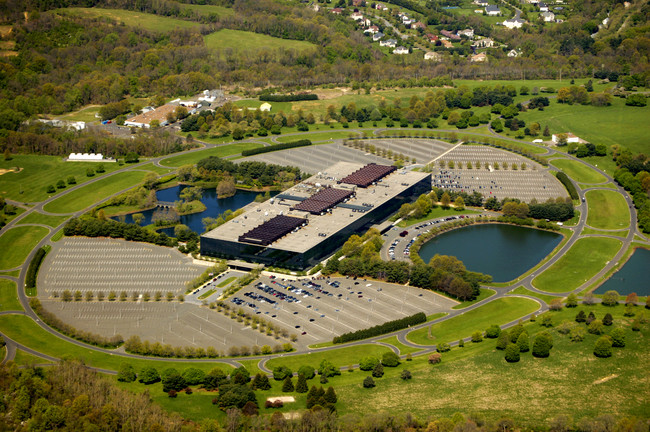
Ever since the Eero Saarinen–designed Bell Labs building in central New Jersey closed six years ago, its fate has hung in the balance. Now the iconic edifice that was once the site of enormous technological innovation will re-emerge as a civic center for the surrounding town of Holmdel.
 |
| Photo © Ezra Stoller/Esto The atrium of the building, as it looked when it was completed. |
Somerset Development purchased the 1.9-million-square-foot building and the surrounding pastoral grounds from Alcatel-Lucent this summer, securing the future for the vacant structure, which closed in 2007 when the French telecommunications company consolidated its research facilities. At one point, another developer suggested razing the structure, an option that was scrapped after scientists and architects from around the world blasted the idea. And in August, the township of Holmdel approved a redevelopment plan for the site, ensuring the structure’s survival. With its future now settled, architects must decide how to transform the vaunted building into a viable mixed-use complex with a health center, hotel, offices, retail, and a library.
The mirrored-glass structure opened in 1962 as a place to foster scientific innovation among AT&T employees at a time when the company had a monopolistic hold on the telecommunications industry. Alcatel-Lucent eventually acquired the property from AT&T. The expansive hallways of the six-story building were designed so scientists might accidentally encounter one another and perhaps stop for a cigarette near one of the built-in ashtrays on the balcony ledges. The design served its purpose: Bell Labs employees contributed to the inventions of touch-tone dialing, lasers, the microwave, and the cell phone. But reimagining this historic structure for a new era is not a simple task. “You have to think out of the box, and this is a glass box, literally,” says Alexander Gorlin, the architect tapped to lead the redesign effort. NK Architects and Joshua Zinder Architecture + Design, both based in New Jersey, will design interior tenant spaces.
As Somerset begins the task of luring tenants, Gorlin and his team will bring the common spaces back to life. The entryway will be restored, and a heavy awning added later will be removed. Already, Somerset has begun restoring the Sasaki, Walker & Associates-designed landscape to its original glory. The 470-acre grounds include lakes, wetlands, and fields. Although Somerset plans to sell 237 acres to the national homebuilder Toll Brothers, the remaining land will eventually include bike paths, pedestrian walkways, and an outdoor sports center.
But in order for the ambitious $100 million redevelopment to succeed, Somerset must draw tenants to a property set on a quiet road in a wealthy rural community. Although Bell Labs is close to the Garden State Parkway, most of the town’s retail is a 10-minute drive away. Somerset envisions a new center for Holmdel, punctuated by 225 new houses that will rise on the outer edge of the original property.
A health-care developer intends to create a 400,000-square-foot health and wellness center in the building, and the town will move its library there. But so far no other tenants have committed to the project, which will include 50,000 square feet of retail. “We are in a classic chicken-and-egg situation,” says Ralph Zucker, president of Somerset. “People want to be there because of the restaurants, and the restaurants want to be there because of the offices. So what comes first?”
Meanwhile, Gorlin will set to work restoring the quarter-mile-long atrium that runs the length of the building and acts as an avenue. Daylight pours in through the glass ceiling. Zucker hopes to improve the lighting and acoustics so it can be used for a marketplace and events. “When Alex walks around the building, you can almost see him relating to every nut and bolt. It really speaks to him, and it’s important to us that we have an architect who is not looking to put his imprint on the building but rather to help us complement what is already there,” says Zucker. “He really gets it. He is somebody who understands Midcentury Modern architecture, understands Saarinen, understands the building.” Another immediate challenge: clad in single-pane glass with inoperable windows, it was designed at a time when energy was cheap. The mechanical equipment is aging. Zucker is considering installing a co-generation plant for cooling and heating. The interior, however, was created as four separate buildings contained within a glass curtain wall. So those offices are surprisingly well-insulated. “The single biggest challenge is the role of the skin of the building,” says Michael Calafati, an architect and chairman of the American Institute of Architects’ New Jersey Historic Resources Committee. “It’s a colossal building without one operable window.”
Recently, Gorlin began sifting through Saarinen’s original Mylar and pencil drawings. Although they connect him to the man who designed the Gateway Arch in St. Louis and Lincoln Center’s Vivian Beaumont Theater, Gorlin says he is not intimidated by the challenge. In the next two months, he will release renderings of a master plan so that even as pieces of the building are parceled off—like the hotel—the final result will have a single vision. “There won’t be a hodgepodge of signage or facades,” says Gorlin. “We’re providing a framework for all future development to fit within the box.”

Post a comment to this article
Report Abusive Comment